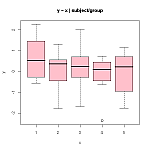
You're trying to explain null and alternative hypotheses to one of the senior managers at Company W and he's not
You're trying to explain null and alternative hypotheses to one of the senior managers at Company W and he's not "getting it" when you use snack food sales. Help him by thinking about a business problem in another organization or department. Formulate a null hypothesis and the corresponding alternative hypothesis that could be tested.
Solution: Hypothesis Testing is a statistical tool which allows us to verify statements about populations. The statements we want to verify are usually expressed in terms of the null and alternative hypotheses. The null hypothesis represents the statement we want to test. We assume it is true unless we have enough evidence to reject it. In that case, if we reject the null hypothesis, we accept the alternative hypothesis, or at least we accept that the evidence suggest that the alternative hypothesis could be true.
Now, the procedure to decide that there’s enough evidence to reject the null hypothesis is not exact and we can make mistakes. If we reject the null hypothesis when it’s true, that’s Type I error. If we don’t reject the null hypothesis when it’s false, that’s Type II error. Both errors are undesirable, but there’s no way to eliminate them. Most of the tests concentrate on having a small Type I error, and they don’t have much control over the Type II error. This especially justifies in a situation where it’s not desirable to have Type I error. For instance, when the judge is deciding the fate of a person, she doesn’t want to send to jail (reject the null hypothesis) when the person is innocent (null hypothesis true).
Things could get clearer with an example:
A brewery distributes beer in bottles labeled 32 oz. The local Bureau of Weights and Measure randomly selects 50 of these bottles, measures their contents, and obtains a sample mean of 31 oz. Assuming that the standard deviation is known to be 0.75 oz., is it valid at the 0.01 significance level to conclude that the brewery is cheating costumers?
To solve this problem, we define the null and alternative hypotheses as:
![]()
where![]() corresponds to the population mean content in a bottle. In a way, the company is assumed to be innocent until the contrary is proven, that’s why we set
corresponds to the population mean content in a bottle. In a way, the company is assumed to be innocent until the contrary is proven, that’s why we set ![]() to be that the company is telling the truth. Only if we have enough evidence we’re going to reject the null hypothesis and accept the alternative.
to be that the company is telling the truth. Only if we have enough evidence we’re going to reject the null hypothesis and accept the alternative.
We use a z-test, and we compute the A-statistic:
![]()
Now, if the null hypothesis were true, and then ![]() would have a
would have a ![]() (standard normal) distribution, and the value obtained for the Z statistics would be very odd. The critical value is -2.33 for the 0.01 level of significance (the most extreme value that wouldn’t be considered odd), so we are way beyond it. Therefore, if the null hypothesis were true, it would be very unlikely to have such an odd outcome. We reject then the null hypothesis, which suggests that the company is cheating customers.
(standard normal) distribution, and the value obtained for the Z statistics would be very odd. The critical value is -2.33 for the 0.01 level of significance (the most extreme value that wouldn’t be considered odd), so we are way beyond it. Therefore, if the null hypothesis were true, it would be very unlikely to have such an odd outcome. We reject then the null hypothesis, which suggests that the company is cheating customers.
Hypothesis Testing Solution Summary
A hypothesis testing is conducted to make a claim about a population parameter. In other words, small sample information is used to make a statement about the whole population.
The idea is to select a random sample, so that the sample is representative and contains enough information about the population.
Related Content


Collection of Solved Statistics Problems - StatisticsHelp

Combining Efforts with a Statistics Expert - StatisticsHelp

